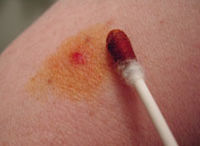
Reply to Are we certain that chlorhexidine gluconate bathing is not beneficial in deducing central line associated blood stream infections among children with cancer or undergoing hematopoietic stem cell transplantation?
Sign Up to like & getrecommendations! Published in 2021 at "Cancer"
DOI: 10.1002/cncr.33570
Abstract: We appreciate the thoughtful comments provided by Hord and Dandoy regarding our article titled “Chlorhexidine Gluconate Bathing in Children With Cancer or Those Undergoing Hematopoietic Stem Cell Transplantation: A DoubleBlinded Randomized Controlled Trial From the… read more here.
Keywords: cell transplantation; cancer undergoing; chlorhexidine gluconate; cancer ... See more keywords

Comparative evaluation of intermediate solutions in prevention of brown precipitate formed from sodium hypochlorite and chlorhexidine gluconate
Sign Up to like & getrecommendations! Published in 2022 at "Clinical and Experimental Dental Research"
DOI: 10.1002/cre2.654
Abstract: To evaluate intermediate treatments between sodium hypochlorite and chlorhexidine gluconate irrigations for the prevention of a toxic brown precipitate in root canal therapy. read more here.
Keywords: hypochlorite chlorhexidine; brown precipitate; sodium hypochlorite; chlorhexidine gluconate ... See more keywords

Randomized controlled trial evaluating the antimicrobial efficacy of chlorhexidine gluconate and para-chloro-meta-xylenol handwash formulations in real-world doses.
Sign Up to like & getrecommendations! Published in 2019 at "American journal of infection control"
DOI: 10.1016/j.ajic.2018.10.027
Abstract: Chlorhexidine gluconate-based soaps have become the gold standard for handwashing in critical care settings and para-chloro-meta-xylenol is an effective alternative antibacterial active ingredient. This study benchmarked 2 novel foaming handwashes, compared to a bland soap… read more here.
Keywords: chlorhexidine gluconate; meta xylenol; para chloro; chloro meta ... See more keywords

Effect of chlorhexidine gluconate on mechanical and anti-microbial properties of thermoplastic cassava starch.
Sign Up to like & getrecommendations! Published in 2022 at "Carbohydrate polymers"
DOI: 10.1016/j.carbpol.2021.118690
Abstract: Antimicrobial thermoplastic starch (TPS) was developed using cassava starch, glycerol, and chlorhexidine gluconate (CHG) blend. CHG was added at concentrations of 1%, 5%, 10%, and 20% (wt./wt.) as an antimicrobial additive. The tensile strength and… read more here.
Keywords: anti microbial; cassava starch; microbial properties; chlorhexidine gluconate ... See more keywords

Pre-Operative Skin Antisepsis with Chlorhexidine Gluconate and Povidone-Iodine to Prevent Port-Site Infection in Laparoscopic Cholecystectomy: A Prospective Study.
Sign Up to like & getrecommendations! Published in 2018 at "Surgical infections"
DOI: 10.1089/sur.2017.269
Abstract: BACKGROUND Skin preparation with antiseptic agents is commonly recommended for incisional site cleansing before surgery. We present the result of a prospective case series submitted to a scheduled pre-operative antiseptic procedure combining chlorhexidine gluconate and… read more here.
Keywords: povidone iodine; pre operative; port site; chlorhexidine gluconate ... See more keywords

Evaluation of Compatibility of a Gum Mastic Liquid Adhesive and Liquid Adhesive Remover With an Alcoholic Chlorhexidine Gluconate Skin Preparation
Sign Up to like & getrecommendations! Published in 2017 at "Journal of Infusion Nursing"
DOI: 10.1097/nan.0000000000000230
Abstract: The compatibility of a 2% chlorhexidine gluconate/70% isopropyl alcohol (CHG/IPA) skin preparation with a gum mastic liquid adhesive (GMLA) and liquid adhesive remover (LAR) was assessed in healthy volunteers. Twenty subjects completed test material combination… read more here.
Keywords: gum mastic; liquid; chg ipa; chlorhexidine gluconate ... See more keywords

Aqueous chlorhexidine is an effective alternative to povidone–iodine for intravitreal injection prophylaxis
Sign Up to like & getrecommendations! Published in 2017 at "Acta Ophthalmologica"
DOI: 10.1111/aos.13340
Abstract: Editor, W e would like to thank Grzybowski & Brona (2016) for their interest in our work regarding the use of chlorhexidine gluconate as an alternative to povidone–iodine for asepsis in intravitreal injections (IVI). Highlighting… read more here.
Keywords: povidone; povidone iodine; iodine; chlorhexidine gluconate ... See more keywords

Chlorhexidine Gluconate Baths: Supporting daily use to reduce central line‐associated bloodstream infections affecting immunocompromised patients
Sign Up to like & getrecommendations! Published in 2019 at "Clinical Journal of Oncology Nursing"
DOI: 10.1188/19.cjon.e32-e38
Abstract: BACKGROUND: Chlorhexidine gluconate (CHG) has a broad‐spectrum antimicrobial property that has proven to be effective in prolonging skin antisepsis and decreasing pathogens often seen in oncology units. Figure. No caption available. OBJECTIVES: The aim was… read more here.
Keywords: central line; chlorhexidine gluconate; line associated; oncology ... See more keywords

Influence of Chlorhexidine Gluconate on the Immediate Bond Strength of a Universal Adhesive System on Dentine Subjected to Different Bonding Protocols: An In Vitro Pilot Study.
Sign Up to like & getrecommendations! Published in 2020 at "Oral health & preventive dentistry"
DOI: 10.3290/j.ohpd.a43934
Abstract: PURPOSE The aim of this in vitro study was to evaluate the influence of preapplication of 2% chlorhexidine gluconate on the immediate microtensile bond strength of a universal adhesive system on dentine subjected to different… read more here.
Keywords: bond; chlorhexidine gluconate; bond strength;

Anti-oomycete Activity of Chlorhexidine Gluconate: Molecular Docking and in vitro Studies
Sign Up to like & getrecommendations! Published in 2022 at "Frontiers in Veterinary Science"
DOI: 10.3389/fvets.2022.909570
Abstract: Saprolegniosis is one of the most catastrophic oomycete diseases of freshwater fish caused by the members of the genus Saprolegnia. The disease is responsible for huge economic losses in the aquaculture industry worldwide. Until 2002,… read more here.
Keywords: molecular docking; activity chlorhexidine; chlorhexidine gluconate; oomycete activity ... See more keywords

Salmonella spp. in Pet Reptiles in Portugal: Prevalence and Chlorhexidine Gluconate Antimicrobial Efficacy
Sign Up to like & getrecommendations! Published in 2021 at "Antibiotics"
DOI: 10.3390/antibiotics10030324
Abstract: A fraction of human Salmonella infections is associated with direct contact with reptiles, yet the number of reptile-associated Salmonellosis cases are believed to be underestimated. Existing data on Salmonella spp. transmission by reptiles in Portugal… read more here.
Keywords: pet reptiles; salmonella spp; salmonella; spp pet ... See more keywords